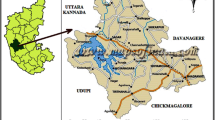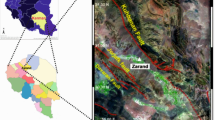Abstract
The radon concentration has been measured in 44 drinking water resources, in villages nearby Lalehzar fault in winter 2014. Some samples showed a higher concentration of radon surpassing limit set by EPA. Further, a sample was taken from water distribution networks for these sources of water. Soluble radon concentration was measured by RAD7 device. Range radon concentration was 26.88 and 0.74 BqL−1 respectively. The maximum and minimum annual effective dose for adults was estimated at 52.7 and 2.29 µSvY−1, respectively. Reducing radon from water before use is recommended to improve public health.




Similar content being viewed by others
References
United Nations Scientific Committee on the Effects of Atomic Radiation (UNSCEAR) (1993) Exposures from natural sources of radiation. Annex A, United Nations, New York
Kito ME, Kuhland MK, Dansereau RE (1996) Direct comparison of three methods for the determination of radon in well water. Health Phys 70:358–362
Choubey VM, Bartarya SK, Ramola RC (2005) Radon variations in an active landslide zone along the Pindar River, in Chamoli District, Garhwal Lesser Himalaya, India. Environ Geol 47:745–750
Wang X, LI Y, DU J, Zhou X (2014) Correlations between radon in soil gas and the activity of seismogenic faults in the Tangshan area, North China. Radiat Meas 60:8–14
Choubey V, Mukherjee P, Bajwa B, Walia V (2007) Geological and tectonic influence on water–soil–radon relationship in Mandi-Manali area, Himachal Himalaya. Environ Geol 52:1163–1171
Ujić P, Čeliković I, Kandić A, Vukanac I, Đurašević M, Dragosavac D, Žunić ZS (2010) Internal exposure from building materials exhaling 222Rn and 220Rn as Compared to external exposure due to their natural radioactivity content. Appl Radiat Isot 68:201–206
Erdogan M, Eren N, Demirel S, Zedef V (2013) Determination of radon concentration levels in well water in Konya, Turkey. Radiat Prot Dosim 156:489–494
AL zabadi H, Musmar S, Issa S, Dwaikat N, Saffarini G (2012) Exposure assessment of radon in the drinking water supplies: a descriptive study in Palestine. BMC Res Notes 5:29
Binesh A, Mohammadi S, Mowlavi A, Parvaresh P (2010) Evaluation of the radiation dose from radon ingestion and inhalation in drinking water. Int J Water Resour Environ Eng 2(7):174–178
Field RW(2005) Radon occurrence and health risk. Department of Occupational and Environmental Health, Department of Epidemiology, College of Public Health, 104 IREH, University of Iowa, Iowa
Nsiah-Akoto I, Andam AB, Amponsah P, Hood CO (2013) The radon health hazards education in Ghana. Elixir Geosci 56:13399–13401
WHO (2009) Handbook on indoor radon, a public health perspective. World Health Organization, Geneva
Bem H, Plota U, Staniszewska M, Bem EM, Mazurek D (2014) Radon (222Rn) in underground drinking water supplies of the Southern Greater Poland Region. J Radioanal Nucl Chem 299:1307–1312
Somashekar R, Ravikumar P (2010) Radon concentration in groundwater of Varahi and Markandeya river basins, Karnataka State India. J Radioanal Nucl Chem 285(2):343–351
Malakootian M, Salmani H (2014) Determination of radon level in drinking water in Mehriz villages and evaluation the annual effective absorbed dose. J Commun Health Res (in press)
Idriss H, Salih I, Sam AK (2011) Study of radon in ground water and physicochemical parameters in Khartoum state. J Radioanal Nucl Chem 290(2):333–338
Moldovan M, Nita DC, Cucos-Dinu A, Dicu T, Bican-Bris¸an N, Cosma C (2014) Radon concentration in drinking water and supplementary exposure in Baita-stei mining area, Bihor county (Romania). Radiat Prot Dosim 158(4):447–452
Khodami A, Bouzari S, Shafiei A (2010) Morphotectonic indices of Lalehzar Fault in South of Bardsir. J Earth Spring 5:103–110
Geological Map Of Bardsir, (1.100000), (1992) Geological Survey of Iran
EL-Taher A (2012) Measurement of radon concentrations and their annual effective dose exposure in groundwater from Qassim Area, Saudi Arabia, J Environ Sci Technol, 5:1–7
United Nations Scientific Committee on the Effects of Atomic Radiations (UNSCEAR) (2000) The general assembly with scientific annex. United Nation, New York
Asadi A, Rahimi M (2013) Determination of the annual effective dose absorbed by the people of Rafsanjan City and surrounding areas with measurement of radon gas concentration in drinking water using active method. Iran Conference Paper 23:1753–1756
WHO (2008) World Health Organization Guidelines for third edition recommendations drinking-water quality, vol 1. World Health Organization, Geneva
Lefta SH, Ibrahim JH (2013) Radon concentration of ground water in Babylon Governorate. Acad Res Int 4:260–263
Malakootian M, Khashi Z, Iranmanesh F, Rahimi M (2014) Measurement of radon concentration in drinking water in villages nearby Rafsanjan fault and the annual effective absorption dose calculated water. J Radioanal Nucl Chem 302(3):1167–1176
Khattak N, Khan M, Shah M, Javed M (2011) Radon concentration in drinking water sources of the Main Campus of the University of Peshawar and surrounding areas, Khyber Pakhtunkhwa, Pakistan. J Radioanal Nucl Chem 290(2):493–505
Asadi A, Ranjbar Askari H, Rahimi M, Jabbari L (2010) Evaluation and measurement of radon concentration in groundwater Anar city and surrounding areas Anar fault, the 17th Iranian s Nuclear Conference
Akawwi E (2014) Radon-222 concentrations in the groundwater along Eastern Jordan Rift. J Appl Sci 14(4):309–316
Acknowledgments
This research formed of a Master’s thesis. It was conducted at the Environmental Health Engineering Research Center and sponsored by the Vice-Chancellor for Research and Technology of Kerman University of Medical Sciences. We would like to express our gratitude to this University for all assistance extended, to the Physics Department of Vali-e-asr University of Rafsanjan and to all those involved in the realization of this research.
Author information
Authors and Affiliations
Corresponding author
Rights and permissions
About this article
Cite this article
Malakootian, M., Darabi Fard, Z. & Rahimi, M. Determination of radon concentration in drinking water resources of villages nearby Lalehzar fault and evaluation the annual effective dose. J Radioanal Nucl Chem 304, 805–815 (2015). https://doi.org/10.1007/s10967-014-3845-z
Received:
Published:
Issue Date:
DOI: https://doi.org/10.1007/s10967-014-3845-z




